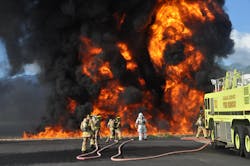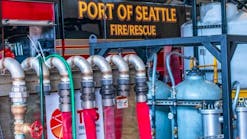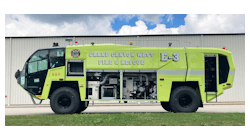Know Your Needs for ARFF Equipment
The Hawaii Department of Transportation Airports Division purchased 14 ARFF vehicles in the past two years and has set bids for four more 1,500-gallon vehicles and two 4,500 vehicles.
Martinez Jacobs, airports fire chief for HDOTA, said there are 52 trucks across Hawaiian airports and they’re currently implementing Oshkosh Global Strikers, replacing equipment that’s 12 to 15 years old.
“It all depends on the usage,” he said. “A truck at Honolulu or Maui will get heavy usage, but if you go to the Big Island, the usage is probably about half of that.”
ANA All Nippon Airways (ANA) recently began A380 service to Honolulu International Airport, so Jacobs said they needed to update their airport emergency plan. ICAO made a special Category 10 for the A380. Jacobs said Honolulu is a Category 8 in ICAO and FAA Category E, which is the highest level for Part 139.
“The FAA will support three vehicles with 6,000 gallons,” he said. “So in the event that we really have something go down, we have additional backup trucks that we can run out to the scene.
Honolulu also has assistance of Hickam Air Force Base in the event of a major incident, but the other airports in the state don’t have that same resource, so Jacobs said maintenance and training are key elements to making sure the equipment is performing optimal.
“They do initial training and a year after that initial training, we put everyone through that same training again,” he said. “If you’re operating the truck improperly, then it’s going to problems, especially when you make mistakes and operator error.
“The better trained the operator is, the better they can analyze a situation when it’s happening will help preserve the life of the truck.”
Ocala International Airport in Ocala, Fla., put its new ARFF vehicle into service in December, replacing a 20-year-old unit, which the airport bought at auction in 2008.
Matthew Grow, airport director at Ocala International Airport, said they opted for a new unit because it only cost the airport $27,000 to obtain the $540,000 vehicle. The Federal Aviation Administration (FAA) kicked in $486,000 towards the unit and the Florida Department of Transportation (FODT) also helped cover the cost of the vehicle.
“When you look at it compared to what we had, it was such a simple decision,” he said. “The ARFF industry has grown and transformed and incorporated so many new technologies in their vehicles compared to what we had from a 1998 truck. From the suspension to computerized agent disbursal, the pump mechanism the dynamics and diagnostics.
“We had a really dated piece of equipment.
Ocala is primarily a general aviation facility with some charter flights, but Grow said given the high volume of equine cargo coming through the facility makes it necessary for having ARFF coverage.
“Less than 1 percent of our operations requires that ARFF coverage, but that 1 percent the value of the cargo exceeds several hundred millions of dollars,” he said.
The old ARFF unit was one of E-One’s original Titan units, Grow said. The maintenance costs began to balloon, so they knew it was time to look for a new piece of equipment.
“The parts it needed were literally like Unobtainium,” he said E-One couldn’t even fix their own truck anymore, even though their manufacturing facility is located right across the street from the Ocala airport.”
Know your needs
Randal Rhodes, assistant fire chief with Dallas Fort Worth International Airport’s Department of Public Safety, said airports and the fire services that support commercial airports should look at ARFF technology needs from the standpoint of several key elements: business performance (will this keep the airport in regulatory compliance); operational excellence (will the technology have a continued positive impact of emergency operations; and safe and secure (does it work and does it function well).
“[T]he agency/airport ‘should’ review the FAA FAR regulations, Aviation Circulars, and review adopted standards under the National Fire Protection Agency (NFPA) for guidance on required technology requirements and current standards for use of such technology,” he said. “Additionally, airports and agencies need to look at the need for technology based upon various response conditions. One example is certain visual aid technology an airport in San Francisco might need due to the famous foggy weather versus an airport in the desert.
“Ask the question, ‘Does the technology need to be fixed to the vehicle, or can it be operated by the operator like heat detection systems?’”
For establishing a time frame to make new purchases, there are a couple of different approaches an airport / fire department can use as a guideline. One way is to make purchases on a rotational basis. Rhodes said some departments will use an operational period, such as every 10 years, to replace old equipment with new. The benefits allow an airport/department to plan accordingly for budgets, knowing the replacement schedule is pre-determined. The downside to this model is the potential significant capital expenditure over a given budget year to purchase and integrate the new equipment.
Another approach is to tract maintenance and downtime versus residual value as the equipment ages. Once the ARFF equipment’s maintenance cost of increasing downtime exceeds its overall value, the equipment is replaced.
“The benefit to this model is the capital expenses are distributed over a multi-year budget process, decreasing the ‘shock’ to the bottom line. The downside is continued tracking of maintenance, downtime and equipment failures,” Rhodes said. “From a equipment operator’s perspective, the expectation of the airport or department is to consider replacement or new equipment before safety is potentially compromised. If an add-on, new piece of technology comes along, a collaboration between the operators, airport decision makers, and the fire department is formed to perform a cost-benefit analysis to determine the effectiveness and efficiently of the new technology.
Rhodes said fire fighter health and safety have always been concerns. Manufacturers are looking at medical embedded fire fighting gear so incident safety officers and incident commanders can monitor the health of each responder in various response roles. The ability to monitor the heart, blood pressure, temperatures and location can be very important to the safety of the fire fighter. Other technologies can enhance the response safety of drivers, vehicles and survivors by providing enhance driving capabilities through enhanced vision.
“Airports and ARFF fire departments can work closely with technology and equipment manufacturers and with regulatory agencies to ensure a collaborative effort is present when opportunities exist for integration of new equipment and technology for first responders,” he said. “From a first responder’s perspective, if the equipment or technology isn’t reliable or has a short lifespan, they may be hesitant to use it when needed.
Training plans were developed through years of data collection, maintenance records, attending seminars and seeing what types of best practices other airports have been implementing, Jacobs said.
“You have a much deeper understanding of the components that are needed to operate a good ARFF apparatus program and to keep operational readiness,” he said. “Operational readiness is a key component here.”
Learning to better maintain the old equipment also allowed HDOTA to keep the vehicles as backup units, Jacobs said.
“It takes a lot, but you want to treat it like it’s your car,” he said. “Now when you look at a truck, it’s still clean, we know the mechanics are really trained good, we have good maintenance practices, we have continual training and we have good operator training because we have continual training.”
When picking equipment, it’s important to consider all the needs outside of the FAA regulation. Jacobs said HDOTA learned having lights all around the vehicles has helped along with rear steering vehicles, which cuts down on tire wear.
Jacobs recommended doing a gap analysis to see what’s lacking in your program when picking new ARFF equipment and also getting firefighters to seminars and other opportunities so they know what they need.
“Training is the most important factor,” he said. “Then being able to go back day-to-day and evaluate the truck in the same way you evaluate the truck when your first got it. That evaluation methodology will save the truck wear and tear and it will provide an extended life.”
As with any new piece of technology entering a career field, there will be some time to learn and become confident with the new system. Rhodes said defining a lead time is best determined by the type of technology under consideration. Time to train is dependent on if the technology is a whole new system or a significant enhancement to the current system.
An example of this is the High Reach Extendable Turret (HRET) system available to ARFF vehicles. As a new system, training was complex with classroom training, hands-on training and skills training in the field. After the system was in use, manufacturers came out with an enhanced camera system utilizing normal vision and heat detection vision to aid them in the use of the system. The degree of training was not too labor intensive for current operators in order to effectively use the system.
Some departments may enlist the assistance of their risk management department to possibly perform a risk analysis which would include pre and post-purchase training. Another consideration to include in the decision process is who is qualified to train and/or where can this training be accomplished. Manufacturers may provide a comprehensive training program while other departments may seek out experienced training facilities.
“This was part of the vision for the DFW Airport Fire Training Research Center (FTRC). The FTRC is well known for its excellent training programs, but the center also provides manufacturers a near real-life fire fighting situation(s) to test and validate the technology but also the training program to train users of the technology,” Rhodes said. “This research side of the FTRC has allowed the center to keep up with technology advances but also the opportunity to become subject matter experts (SME’s) in a variety of updated technology opportunities.”
Grow said Ocala went with the new redesign of the Titan line by E-One, which is the fist vehicle of its type put into service. He said the company put it through extensive testing before placing it into service at Ocala and the company is located across the street from the airport, making for a prime location in need of service.
The airport brought in both members from the Ocala Fire Department and the city’s fleet management department to help write the spec for the vehicle. Grow said having the new equipment improved the overall moral of the firefighters as well.
“Our firefighters absolutely love it,” Grow said. “It’s almost the same feeling as when you buy that grail car and put it in your parking garage at home and you develop a relationship with that vehicle.
“I believe that our firefighters have developed a relationship with this new vehicle. They take care of it, they take it our and walk it every day, they adore it, they take care of it, they like showing it off and they hope to never use it, but if they do it’s going to be perfect.
Grow recommended airports consider the long-term cost of equipment when determining the future of it’s ARFF units.
“Make sure whomever the manufacturer or supplier is, make sure they have a good maintenance agreement in place that will cover the airport and make sure it’s from a reputable company that can follow through with their promises,” he said. “It’s always the long-term costs that get you in the end.




